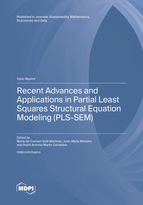Topic Menu
► Topic MenuTopic Editors



Recent Advances and Applications in Partial Least Squares Structural Equation Modeling (PLS-SEM)

A printed edition is available here.
Topic Information
Dear Colleagues,
Partial Least Squares Structural Equation Modeling (PLS-SEM) represents a new generation statistical data analysis technique that, despite its recent creation, is gaining popularity in academia exponentially: it has attracted the interest of scholars in various methodologies, becoming a vivid and constantly evolving technique. In today's world, managers of companies and public administrations, academics, and researchers have at their disposal a large amount of data to analyze for decision-making and the discovery of new findings. This requires the establishment of a theoretical framework, the use of sciences such as mathematics and statistics, as well as experience and intuition. In this regard, PLS-SEM involves a multivariate data analysis technique that combines the methodologies of regression and linear analysis. It is widely employed in the fields of business, management and accounting, social sciences, economics, finance, environmental sciences, medicine and health professions, etc., where it is necessary to handle unobservable or latent variables. It allows jointly analyzing the relationships between observable and latent variables (evaluation of the measurement model) and the relationships between latent variables (evaluation of the structural model). Thus, this special and multidisciplinary issue focuses on the application of PLS-SEM, providing a platform for researchers to present their novel and unpublished papers with attractive results.
Dr. María del Carmen Valls Martínez
Prof. Dr. José-María Montero
Dr. Pedro Antonio Martín Cervantes
Topic Editors
Keywords
- PLS-SEM
- structural equations
- economics
- finance
- healthcare
- sustainability
- environment
Participating Journals
| Journal Name | Impact Factor | CiteScore | Launched Year | First Decision (median) | APC |
|---|---|---|---|---|---|

Economies
|
2.6 | 3.2 | 2013 | 21.4 Days | CHF 1800 |

Journal of Risk and Financial Management
|
- | 2.8 | 2008 | 20.5 Days | CHF 1400 |

Mathematics
|
2.4 | 3.5 | 2013 | 16.9 Days | CHF 2600 |

Sustainability
|
3.9 | 5.8 | 2009 | 18.8 Days | CHF 2400 |

Data
|
2.6 | 4.6 | 2016 | 22 Days | CHF 1600 |

MDPI Topics is cooperating with Preprints.org and has built a direct connection between MDPI journals and Preprints.org. Authors are encouraged to enjoy the benefits by posting a preprint at Preprints.org prior to publication:
- Immediately share your ideas ahead of publication and establish your research priority;
- Protect your idea from being stolen with this time-stamped preprint article;
- Enhance the exposure and impact of your research;
- Receive feedback from your peers in advance;
- Have it indexed in Web of Science (Preprint Citation Index), Google Scholar, Crossref, SHARE, PrePubMed, Scilit and Europe PMC.

